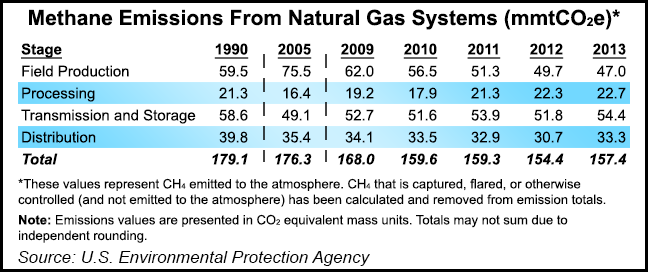Report Urges States to Take Lead on Reducing Methane Emissions
States can lead the way on efforts to reduce methane emissions from natural gas development, and help shape federal emission standards in the process, but both levels of government are behind the times on regulation and must take action soon if the U.S. is to meet its emissions targets, according to the World Resources Institute (WRI).

In a 24-page paper released Wednesday, WRI said that while methane emissions are nothing new, they have become a much more important issue in the wake of booming domestic natural gas production. The institute said that while reducing leakage over the natural gas lifecycle to 1% or less of total production is an achievable and cost-effective goal in the near term, some recent studies suggest current methane emissions from U.S. natural gas systems are leaking more than 1% (see Daily GPI,April 1; Feb. 14, 2014; Shale Daily, March 24; Nov. 27, 2013; Aug. 6, 2013).
“State regulators and legislators have a number of tools at their disposal to help companies overcome market barriers to greater implementation of emissions-control technologies and achieve this [1%] benchmark,” said the report’s authors, WRI associates Michael Obeiter and Christopher Weber. “Which of these policy tools makes the most sense can vary by emissions source, the severity of the problem, or local conditions that might pose legal or political challenges.”
While WRI gave a nod to the Bureau of Land Management (BLM) for developing standards to cut methane emissions from drilling on public lands (see Daily GPI, March 18), and to the U.S. Environmental Protection Agency (EPA) for working on a final rule on methane to be unveiled in 2016 (see Daily GPI, Jan. 14), the institute said EPA’s rule will not address existing infrastructure, a major source of methane emissions.
“States have the opportunity to achieve both deeper emissions reductions and public health benefits,” Obeiter and Weber said. “Moreover, differing geologies and other local considerations make state-level policymakers uniquely well positioned to identify the solutions that work best within their jurisdictions…There is still much more that states and the federal government can do to reduce the environmental and climate footprint of natural gas systems.”
WRI said state oil and gas commissions enact standards for natural gas extraction, while state air and environmental agencies can implement air quality rules. State regulators can also enforce safety regulations on interstate transmission pipelines, and public utility commissions can “weigh the costs and benefits of emissions-reduction measures to ensure that ratepayers are not unduly burdened with higher costs.”
WRI added that “states can learn from one another, even if they do not directly collaborate on developing rules.” To illustrate the point, WRI gave the example of Colorado, which enacted rules to help rein in methane in February 2014. The state mandated leak detection and repair (LDAR) systems at well sites, gathering compressor stations and storage vessels (see Daily GPI, Feb. 24, 2014).
“In developing its LDAR rules…Colorado learned from the experiences of Pennsylvania and Wyoming in requiring regular leak detection and repair surveys,” the report said, adding that Ohio enacted its own LDAR requirements two months later (see Shale Daily, April 4, 2014).
“State rules have helped shape federal emissions standards, and momentum is building as states learn from one another and companies share best practices. Yet both states and the federal government are still playing catch-up because the rapid increase in natural gas production in the United States over the past decade has far exceeded the efforts of states and the federal government to impose common sense emissions standards that protect human health without unduly burdening industry.”
According to the WRI, the biggest sources of methane emissions from natural gas systems in 2013 were reciprocating compressors and equipment leaks — each accounted for 19%. Pneumatic devices were the third-highest source for methane (12%), followed by engine exhaust (11%), centrifugal compressors (9%), liquids unloading (4%) and pipeline venting (3%).
Among the best practices and policy recommendations suggested by WRI, on the issue of reciprocating compressors, rod packing systems should be replaced “every three years at existing compressors along transmission lines and on gathering and boosting lines, and require annual maintenance to ensure good working order.” On equipment leaks, WRI said states “should require two-stage LDAR for all production facilities, processing plants, compressor stations and large, above-ground distribution facilities.”
The WRI report also said investors, shareholders and oil and gas companies also have a role to play in reducing methane emissions.
“Investors and shareholders can insist upon a commitment to using proven best practices,” WRI said. “And companies can lay the groundwork for ambitious standards by demonstrating that reducing emissions and turning a profit do not have to be mutually exclusive.”
© 2024 Natural Gas Intelligence. All rights reserved.
ISSN © 1532-1231 | ISSN © 2577-9877 |
